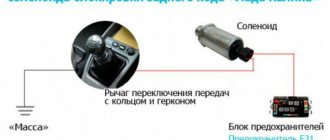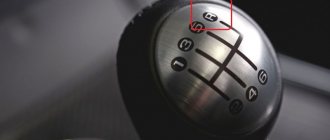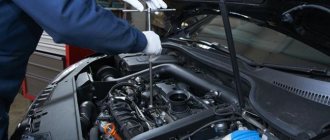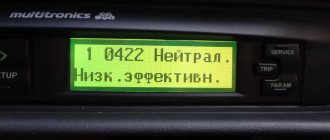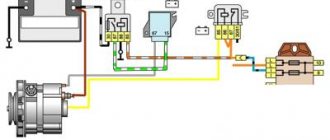Poor activation due to the slider
First, let's look at why first gear doesn't engage well and the problem is with the transmission.
Often the problem with turning on the speed lies in the latch and slider. The appearance of a burr near the groove for the retainer on the slide can easily prevent the ball retainer from entering the groove. When moving the slider, the latch rests on this burr and cannot overcome it without significant effort from the driver. In this case, the gears come very close to each other, but do not engage, and the teeth of one gear hit the other.
In the future, such beating can lead to flaring of the teeth, and the impossibility of engagement will be due to the fact that due to this flaring, the teeth will no longer be able to engage.
Reasons for complete jamming
There are not so many reasons for a complete jamming of the gearbox. One of these reasons is the destruction of the teeth of a gear. Broken tooth fragments can become meshed with the teeth of other gears, which in turn makes the gears unable to rotate.
It is also possible that one of the internal bolts of the box may rupture or spontaneously unscrew. In this case, the bolt gets between the gears and blocks them.
To check whether the cause of jamming is the destruction that occurred inside the box, simply drain the oil from the box crankcase and check it. The fact is that if any element of the box is destroyed, a large amount of metal shavings will get into the oil.
Example in the video: the synchronizer does not help
Diagnostics and replacement of the speed sensor
Let's start answering the last question. Never, under any circumstances, attempt to remove the speed sensor.
It is mounted on the gearbox housing and is accessible. But this does not mean that the sensor is easy to replace.
Speed sensor on box 2181
Even when installing the “old” sensor, it will not be possible to achieve complete tightness. The oil will gradually leave the crankcase, and adding it to the 2181 gearbox will be difficult.
So, the reader understands: dismantling the sensor is prohibited, even if it is not removed for the purpose of replacement.
When gears shift poorly, driving a car becomes not only unpleasant, but also unsafe. Let's look at the main reasons why gears shift poorly or don't shift at all. And since the automatic transmission and manual transmission are too different, we will consider them separately.
Knocks out the first gear of the VAZ 2110 reasons
VAZ 2110 gearbox malfunctions
- January 11, 2009
The VAZ 2110 has been produced for several years now, because all the “sores” of these cars have long been known, both to ordinary owners of “ten” cars and to VAZ itself. The latter seems to be trying to gradually solve these problems, but very gradually. But that's a completely different story, as they say.
In addition to the diseases themselves, their symptoms are also known. In this article we will provide a list of the main possible malfunctions of the VAZ 2110 gearbox and the symptoms by which you can at least roughly identify the problem without disassembling the gearbox.
Noise in the gearbox.
Increased noise during gearbox operation can be caused by the following reasons:
- wear of gear teeth - wear of bearings - insufficient oil level in the box
For those with automatic
If your car has an automatic transmission. It will not hurt you to know the modes in which your machine can operate:
The automatic transmission also has a button on the mode shift lever with the inscription O/D OFF. When it is turned on, the inclusion is prohibited, increasing the gears of the analogue of the 5th gear of the manual transmission. That is, if your automatic machine has 4 gears for moving forward, then for more dynamic acceleration it will use only three lower gears.
About a faulty automatic transmission, an automatic transmission is much more complex than those encountered with a manual transmission, and the chances of repairing it in your garage are slim. But despite this, you still need to know something about it, if only in order not to harm it through improper use.
An automatic transmission is much more demanding in terms of accuracy in maintaining the oil level in it than a manual transmission. Both too low and too high oil levels are very harmful to her. Both of these can lead to serious damage. In both cases, oil foaming occurs. When there is a lack of oil due to the fact that the oil pump begins to capture air along with the oil. When there is excess oil, it foams on the rotating parts, which in this case are immersed in it. Foamed oil compresses better and has low thermal conductivity. Therefore, if you operate a machine with such oil, the pressure in its control systems will be low. Which will lead to slipping of the clutches and their intensive wear. Deteriorated thermal conductivity will not allow all excess heat to be removed. Which, together with low pressure, will lead to the machine failing and requiring serious repairs.
Foamed oil has more volume. Therefore, checking the oil will show the level is too high. If you find that the oil level has risen for no apparent reason, you need to turn off the engine and let the oil settle. After this, check the level again. If it turns out to be low, you need to safely add the required amount and repeat the test.
The oil level in the machine is checked using a dipstick or through a control hole closed with a plug.
How to check the oil level using a dipstick
- Warm up the oil to operating temperature (to do this you need to drive about 15 km).
Select a flat horizontal area for measurement. Put the car on the handbrake.
- Move the lever to select the operating mode of the box through all positions, holding in each position for 3 to 5 seconds, until the machine operates.
- Leave the mode selector in position P, and in this position determine the oil level.
- Without turning off the engine, remove the oil dipstick, wipe it dry and reinsert it into the tube until it stops, then pull it out and read the readings. The upper limit of oil traces on a dry dipstick should be at the mark with the inscription “hot” or in an area with intersecting notches.
If the level is insufficient, you can add oil through the tube into which the dipstick is inserted. Do not forget that the automatic transmission is afraid of dirt, so add only clean new oil. Wipe the dipstick with a clean cloth from which the threads do not fall out.
When checking the oil level, pay attention to its appearance. Dark liquid with a burning smell indicates that not everything is in order in the unit. First, try changing the oil and filter in the automatic transmission. The milky color of ATF indicates that coolant has entered the box. The coolant softens and swells the material from which the clutches are made. Do not hesitate to change such oil, having first eliminated the cause of antifreeze getting into the box, otherwise significant damage will be caused to the machine. Coolant may enter the box due to a leak in the oil section in the radiator of the cooling system. In this case, the emulsion will be observed both in the box and in the engine cooling system.
The most common machine malfunctions
- The car does not move forward or reverse normally. Possible reasons: wear of the forward clutch clutches, a defect in the piston of this clutch, breakage of the rings of the same clutch, jamming of the valve body valves.
- There is no reverse speed, forward there are only 1 and 2. Probable causes: wear of the reverse clutch clutches, a malfunction of the piston of this clutch, damage to the spline joint in the drum body, another defect of this drum.
- There is no rear, everything works forward. Reasons: wear of the brake band, malfunction of the piston of this band or breakage of its rod, defects in the braking package.
- There is no movement either forward or backward when you turn on any mode, there is a shift push, but the car stands still. Causes: torque converter malfunction, lack of oil, clogged filter.
- Only reverse, 1st and 2nd gears are engaged. Reasons: valve jamming in the valve body, low oil level, general wear of pistons and clutch clutches that do not engage.
The clarity of gear engagement and the operation of the entire shift mechanism often worries owners of cars with a manual transmission. A common problem is that after starting the engine, one or more gears are engaged with great effort or not completely, it is not possible to change gears, at the moment of switching on, extraneous noise is heard, unnecessary vibrations appear, etc.
Such malfunctions appear unexpectedly, and difficulties when shifting gears can increase gradually. Speeds may be difficult to switch on “cold” and/or “hot”. It is noteworthy that gears in a manual transmission often shift normally when the engine is turned off.
Read in this article
Repair work
If the adjustment does not give the desired result, you will have to work more carefully with the box. A common problem is knocking out the gears responsible for speeds 1 and 2.
When dismantling, make sure that each individual fastener is in good working order. The latches are springs, of which there are a total of three. The first one is the longest, it is responsible for speeds 1 and 2. The second is medium in size, and its prerogative is 3 and 4 speeds. The third detent is the smallest, and its “guardian” is fifth gear.
Clutch basket
Over time, the clutch basket fails on all cars with a manual transmission. Sometimes it’s due to wear and tear, sometimes the petals or the so-called “spider” break. Let me start, perhaps, with the “spider”, this is a mechanically fixed release bearing on several extensions (done like this on some VAZs), if the extension breaks, then it cannot be effectively fixed to the basket - the gears do not engage.
Next, the petals of the box break, or they become weakened. This leads to the fact that it is very difficult, almost impossible, to release the clutch disc. Therefore, the “speeds” do not switch – we just change the basket.
Well, the last wear and tear is the basket disk. It has a metal disk inside, and over time, especially from high mileage, wear forms there. When starting, the car will shake, and if the wear is very large, the gears may not shift.
In any case, we need to change the clutch basket.
Messages 4
1 Topic by Ursadon 2015-02-01 18:21:12
- Ursadon
- Participant
- Inactive
- From: Novosibirsk
- Registration: 2014-02-15
- Messages: 83 Thanks : 25
- Auto: 21120
Topic: Resolved: 1st and 3rd gear slipping
There was a problem with the 1st gear falling out - if you don’t hold it at the start, it will fly out. Then the second one began to knock out. You can't hold it with your hand. An autopsy showed that the synchronous hub had died. As a result, I replaced: Rod 1-2 Fork 1-2 Locking rings 1, 2 Synchro 1-2 assembly
A week later it started to slip out of 3rd gear, and after another week - into 1st gear, you couldn’t hold it with your hand. The pillows are normal, I also installed a 5th mount - the engine sits firmly.
I myself understand that most likely the synchronizer has fallen apart again and an autopsy will show. However, has anyone had the same problem and how did you solve it?
Tomorrow or the day after tomorrow I’ll take it to a friend’s garage, I’ll take it apart
2 Reply from Goodfree 2015-02-01 22:40:02
- Goodfree
- New member
- Inactive
- Registration: 2014-06-18
- Messages: 82 Thanks : 8
- Auto: 21102
Re: Resolved: 1st and 3rd gears slip out
1st and 3rd gears were falling out. A friend changed the scene and became happy with life.
3 Reply from 7491cm3x 2015-02-01 23:08:44 (2015-02-01 23:09:56 edited by 7491cm3x)
- 7491cm3x
- Connoisseur
- Inactive
- From: Norilsk
- Registration: 2015-01-29
- Messages: 467 Thanks : 119
- Car: VAZ 2112 1.5l 16v
Re: Resolved: 1st and 3rd gears slip out
It was a little different for me: When changing gears, I had to press harder on the lever and shift more smoothly, otherwise the gear would not engage completely and would fly out. First gear could only be engaged through second. In addition, the lever itself dangled quite a lot and it was easy to miss between the first and third. Then I had little experience and I panicked, I thought the box was falling apart. Now I know that this is just a loose curtain. It was then that one master gave me valuable advice: the rocker is made in such a way that it practically never wears out, but there is one bolt on it that often unwinds - and right before my eyes this bolt tightens! That's it, the box works fine and I'm happy =)
4 Reply from Ursadon 2015-02-16 07:39:05
- Ursadon
- Participant
- Inactive
- From: Novosibirsk
- Registration: 2014-02-15
- Messages: 83 Thanks : 25
- Auto: 21120
Re: Resolved: 1st and 3rd gears slip out
Tadaaaam! Taki restored his swallow over the weekend.
I had to hang the box up again. It turned out that the teeth of the gears that mesh with the synchronous clutch were worn out. Just in case, I changed the 3-4 gear clutch assembly.
How does a manual transmission work?
A conventional manual gearbox consists of 3 shafts. These are the primary, intermediate and secondary shafts. The secondary shaft is located coaxially with the primary shaft, inside which there is a bearing into which the end of the secondary shaft fits, allowing it to rotate independently of the primary.
The intermediate shaft is a single unit with gears cast on it. It has a rigid connection through a gear to the input shaft, which causes it to rotate along with the gears of the gears.
Adjusting the gearbox, video instructions
If it is necessary to replace gears, bearings or other parts, the box must be dismantled. Usually in such cases, the VAZ 2110 gearbox is overhauled and elements that have failed are replaced. But removing the box is not always necessary.
It is known that the 10 has problems with gear shifting. In fact, the speed is knocked out.
To eliminate the problem, the unit is equipped with a special mechanism that allows you to adjust the drive.
The operation is performed in the following cases:
- the gearbox was dismantled due to repairs, for example, replacing the input shaft bearings;
- speed knocks out while driving;
- Gears don't engage or disengage easily.
If such situations arise, then adjustments cannot be avoided.
Of course, performing this procedure is much simpler than dismantling work. The work is performed in the following sequence:
- At the bottom of the vehicle there is a nut in a bolt. This fastener holds the transmission linkage in place. The fastening element does not need to be removed: just unscrew the nut a little;
- to move the grooves of the rod and the slot of the fastening clamp apart, just use a flat screwdriver;
- the rod must be set to the neutral position. Then you need to remove the cover from the gearbox handle;
- then the lever is set in accordance with the template;
- at the next stage it is necessary to adjust the backlash of the rear vector rod;
- adjusting axial play;
- At the final stage, the fastening must be installed in place and tightened.
If you have a mechanic
Gears shift poorly in a car with a manual transmission for three reasons. The first of these is a malfunction of the clutch when it does not completely disengage (drive). The first sign of this malfunction is that the reverse gear is engaged with a characteristic crash. The rear one reacts to this anomaly more noticeably than other gears, because it is the only one not equipped with a synchronizer.
The second reason is a defect in the gear selection mechanism of the gearbox. And finally, the third is excessive wear of the gearbox synchronizers.
There are also several clutch malfunctions in which manual transmission gears shift poorly:
Excessive wear of synchronizers mainly occurs in those gears that are engaged more often: these are usually first, second and third. The rear one is not included in this list because it does not have a synchronizer. When your gear shifts poorly, and you assume that the reason for this is wear of the synchronizers, firstly, you should only have difficulties with this while driving. Secondly, in this case it switches better if you use double squeeze.
For those who don’t know what double squeeze is. To shift to a higher gear: depress the clutch, engage neutral, release and depress the clutch again, engage the gear.
Backlash in the so-called “helicopter” is one of the reasons for unclear gear shifting
To switch to a lower gear: double squeezing must be combined with re-engaging, that is, when the clutch pedal is released and the gearbox is in neutral, you need to press and release the accelerator pedal. This is how gears are changed in cars that do not have synchronizers. If the gearbox shifts easier using double squeezing, then the culprit for poor gear shifting is most likely worn synchronizers.
If the gears shift poorly when the car is standing still with the engine turned off, the fault may only be in the gear selection mechanism of the gearbox.
Look for damage or check that it is adjusted correctly. Don't even think about the clutch and synchronizers.
Knocking out the speed
If it turns on, but immediately turns off, then the latch may be stuck in the squeezed position, so it no longer does its job. It is also possible that the spring that presses the ball retainer is destroyed. Without the force of the spring, it will not be able to hold the slider in the desired position.
If significant force is applied while shifting into gear, the shift fork may bend.
Poor switching may also be caused by incorrect installation of the gearshift knob. In this case, the rocker does not bring the gear to full engagement.
